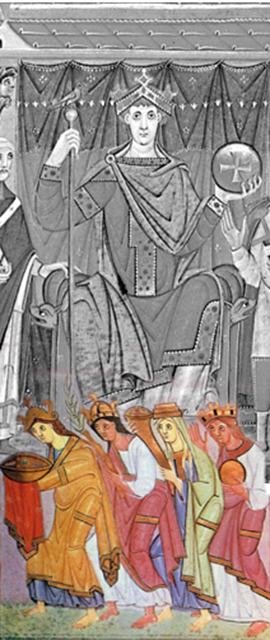Louis II of Italy
Imperial Carolingian identity in ninth-century Italy and its afterlife

Chronicon Casauriense, Paris BNF lat. 5411, fol. 85v
Illustration at the end of the copy of Louis’ foundation charter for the monastery (872)
Louis II of Italy (*c. 825, †875) was the elder son of Emperor Lothar I and was designated as his heir in emperorship early on. In 840 at the age of 15 he was appointed king of Italy by his father and from 855 onwards, he was sole emperor in the west. As compared to his Carolingian relatives in the North, he has received relatively little attention by modern historians – there exists no comprehensive study on his reign. Louis' rule was restricted to the Italian peninsula, but it can only be assessed in connection with the Carolingian realms north of the Alps. Furthermore, Louis was also in constant conflict, communication and cooperation with the so-called Byzantine Empire in the east and the South Italian Lombard principalities, as well as the various Saracen groups of the region, which from their various strongholds were able to launch raids well into Central Italy. The dealings with all of the groups mentioned shall be investigated in the project. On top of that, the project will also have a close look at the political, cultural, religious and material foundations of Carolingian imperial rule in Italy in order to obtain a clearer image of Louis II. The networks of his wife Engelberga and the activities of his daughter Ermengard shall receive special attention. After Louis died quite unexpectedly in 875, his reign was oftentimes glorified, especially in sources stemming from modern-day Italy, also from regions he never really controlled. This analysis of Louis’ ‘afterlife’ will serve as conclusion for the planned book.
The planned monograph will not mainly aim to describe Louis as a historic persona or his image in the transmitted sources, it is rather designed to investigate the possibilities and limits of royal and imperial rule in ninth-century Italy.
